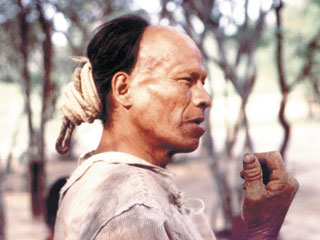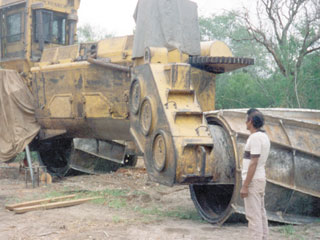Isolated people on the run again in Paraguay
By Rick Kearns, Today correspondent
ASUNCION, Paraguay – After losing almost 15,000 acres of their land to an
illegal ranching business in the last six months, an isolated/uncontacted
tribe in Paraguay is getting some official assistance from their
government and from indigenous activists; but the struggle to protect the
Ayoreo-Totobiegosode is far from over.
On Nov. 13 Paraguay’s National Environmental Council (CONAM) revoked the license of the Yaguarete Pora Company to work in the Chaco forest of western Paraguay in an effort to halt the displacement of the Ayoreo-Totobiegosode people. According to Survival International, a world-wide organization dedicated to advocacy for tribal peoples, Paraguayan officials tried to inspect the region a few days after the license withdrawal but were barred from entering it by personnel from the Brazilian company (who want the land for large scale cattle ranching). SI and other activists had publicized aerial photos of the area being bulldozed.
The Paraguayan officials were able to return in the last week of November but what transpired between the government representatives and Yaguarete Pora Company workers has not been publicized. (The other companies operating in the region, River Plate SA and BBC SA, had not been mentioned in press reports as of late November.)
In the meantime, SI and Paraguayan indigenous leaders have been publicizing the situation and gaining some international help in the process.
“We believe this is currently the most serious threat to tribal peoples anywhere in the world,” according to the SI statement presented to James Anaya, the UN’s Special Rapporteur on Indigenous Issues.
“Unless the Paraguayan government takes urgent measures to stop the deforestation extremely quickly,” the statement continues, “the Ayoreo-Totobiegosode will have little chance of surviving. … Based on past experience, there is an imminent risk of a violent clash between the company workers and the Totobiegosode that could have fatal consequences.”
Along with the risk of violence, the SI statement pointed out that the Ayoreo Totobiegosode were also extremely vulnerable to contact with outsiders due to their lack of immunity to western diseases. While there have not been any reports of epidemics or outbreaks in those communities yet, leaders from the area and from larger Paraguayan indigenous groups are taking their message to the media and to a conference on isolated peoples.
Among the first people from the Ayoreo Totobiegosode to speak out in mid-November was Esoi Chiquenoi who had originally been contacted in 2004 and, along with three other relatives, came to the capital city of Asuncion to address government authorities.
“I’m appealing to the authorities to stop the destruction of our forest,” Chiquenoi said. “My family is there now, that’s where our houses are. More and more notices are appearing on our land prohibiting us from entering. We’re losing our forest.”
“The savages are the ones who are destroying the forest,” said Gabide Etacori, one of the other representatives of the tribe. “We’re the ones who really know the area – it’s where our historical sites and burial grounds are. (Our relatives) need the forest to eat and for water; if the forest is destroyed they will die.”
Spokespeople from a regional organization, the Union of Ayoreo Natives of Paraguay (UNAP), are also attempting to publicize and assist the Totobiegosode. UNAP President Mateo Sobode Chiquenoi spoke at the beginning of an international conference held in Asuncion entitled “From Santa Cruz to Asuncion: Balance and Perspectives on the politics and protective actions of people in isolation and initial contact in South America.”
“These people are killing our land, Eami, the forest,” Chiquenoi said in an interview published by the co-organizers of the conference, the International Indigenous Committee for the Protection of Peoples in Isolation and in Initial Contact of the Amazon, the Grand Chaco and Paraguay’s Eastern Region (CIPIACI).
“Our isolated brothers Ayoreo move around within our ancestral territory of the northern Chaco,” Chiquenoi explained. “We know that there are, at a minimum, five groups that live in different zones. … They are running from one side to another for fear of the ranchers and their bulldozers that are invading our territory.”
Chiquenoi continued, “We always hear the whites saying ‘one must respect private property’ but we don’t see that, we don’t feel that the whites respect our property, our territory and the zones where the isolated Ayoreos live. The ranchers, those that make commerce out of the life of the mountain, don’t respect anything; they destroy, they throw aside, they burn, they kill nature.”
In the conference that Chiquenoi was attending indigenous representatives from Columbia, Ecuador, Peru, Bolivia, Paraguay, and Brazil drafted policy initiatives that they will pursue in their respective countries and on the international stage; among them were a series of proposals to the Paraguayan government that would provide protections to indigenous people and their territories. According to a press release from the conference, Paraguayan officials, including Indigenous Affairs Minister Margarita Mbywangi, did attend the event.
SI also reported that they had sent copies of films of the displacement of the Ayoreo Totobiegosode to every member of the Paraguayan legislature Nov. 27, but lawmakers have not yet publicly commented on the documentaries.
Most Paraguayan officials have also not responded to queries made by ICT regarding future plans for the indigenous issues, although a spokesperson for Minister Mbywangi did say she would forward the questions to the Minister. As of press time, there had been no further communication from that office.
On Nov. 13 Paraguay’s National Environmental Council (CONAM) revoked the license of the Yaguarete Pora Company to work in the Chaco forest of western Paraguay in an effort to halt the displacement of the Ayoreo-Totobiegosode people. According to Survival International, a world-wide organization dedicated to advocacy for tribal peoples, Paraguayan officials tried to inspect the region a few days after the license withdrawal but were barred from entering it by personnel from the Brazilian company (who want the land for large scale cattle ranching). SI and other activists had publicized aerial photos of the area being bulldozed.
The Paraguayan officials were able to return in the last week of November but what transpired between the government representatives and Yaguarete Pora Company workers has not been publicized. (The other companies operating in the region, River Plate SA and BBC SA, had not been mentioned in press reports as of late November.)
In the meantime, SI and Paraguayan indigenous leaders have been publicizing the situation and gaining some international help in the process.
“We believe this is currently the most serious threat to tribal peoples anywhere in the world,” according to the SI statement presented to James Anaya, the UN’s Special Rapporteur on Indigenous Issues.
 |
|
Photo courtesy Ruedi Suter/Survival international © Isolated members of the Ayoreo-Totobiegosode tribe lost some of their land to an illegal ranching business that wanted to build a large scale cattle ranch. |
“Unless the Paraguayan government takes urgent measures to stop the deforestation extremely quickly,” the statement continues, “the Ayoreo-Totobiegosode will have little chance of surviving. … Based on past experience, there is an imminent risk of a violent clash between the company workers and the Totobiegosode that could have fatal consequences.”
Along with the risk of violence, the SI statement pointed out that the Ayoreo Totobiegosode were also extremely vulnerable to contact with outsiders due to their lack of immunity to western diseases. While there have not been any reports of epidemics or outbreaks in those communities yet, leaders from the area and from larger Paraguayan indigenous groups are taking their message to the media and to a conference on isolated peoples.
Among the first people from the Ayoreo Totobiegosode to speak out in mid-November was Esoi Chiquenoi who had originally been contacted in 2004 and, along with three other relatives, came to the capital city of Asuncion to address government authorities.
“I’m appealing to the authorities to stop the destruction of our forest,” Chiquenoi said. “My family is there now, that’s where our houses are. More and more notices are appearing on our land prohibiting us from entering. We’re losing our forest.”
“The savages are the ones who are destroying the forest,” said Gabide Etacori, one of the other representatives of the tribe. “We’re the ones who really know the area – it’s where our historical sites and burial grounds are. (Our relatives) need the forest to eat and for water; if the forest is destroyed they will die.”
Spokespeople from a regional organization, the Union of Ayoreo Natives of Paraguay (UNAP), are also attempting to publicize and assist the Totobiegosode. UNAP President Mateo Sobode Chiquenoi spoke at the beginning of an international conference held in Asuncion entitled “From Santa Cruz to Asuncion: Balance and Perspectives on the politics and protective actions of people in isolation and initial contact in South America.”
“These people are killing our land, Eami, the forest,” Chiquenoi said in an interview published by the co-organizers of the conference, the International Indigenous Committee for the Protection of Peoples in Isolation and in Initial Contact of the Amazon, the Grand Chaco and Paraguay’s Eastern Region (CIPIACI).
“Our isolated brothers Ayoreo move around within our ancestral territory of the northern Chaco,” Chiquenoi explained. “We know that there are, at a minimum, five groups that live in different zones. … They are running from one side to another for fear of the ranchers and their bulldozers that are invading our territory.”
Chiquenoi continued, “We always hear the whites saying ‘one must respect private property’ but we don’t see that, we don’t feel that the whites respect our property, our territory and the zones where the isolated Ayoreos live. The ranchers, those that make commerce out of the life of the mountain, don’t respect anything; they destroy, they throw aside, they burn, they kill nature.”
In the conference that Chiquenoi was attending indigenous representatives from Columbia, Ecuador, Peru, Bolivia, Paraguay, and Brazil drafted policy initiatives that they will pursue in their respective countries and on the international stage; among them were a series of proposals to the Paraguayan government that would provide protections to indigenous people and their territories. According to a press release from the conference, Paraguayan officials, including Indigenous Affairs Minister Margarita Mbywangi, did attend the event.
SI also reported that they had sent copies of films of the displacement of the Ayoreo Totobiegosode to every member of the Paraguayan legislature Nov. 27, but lawmakers have not yet publicly commented on the documentaries.
Most Paraguayan officials have also not responded to queries made by ICT regarding future plans for the indigenous issues, although a spokesperson for Minister Mbywangi did say she would forward the questions to the Minister. As of press time, there had been no further communication from that office.
© 1998 - 2008 Indian Country Today. All Rights Reserved To subscribe or visit go to: http://www.indiancountry.com
